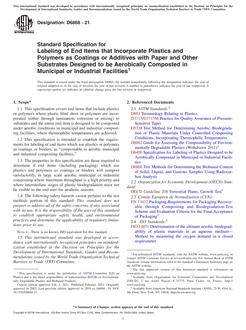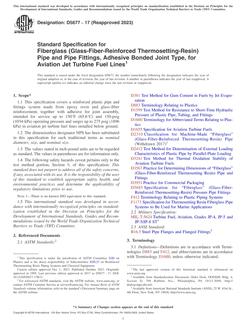1.1 These test methods cover the determination of the flexural modulus and bending strength of both the tangent and deadend Fiber Reinforced Polymer (FRP) composite crossarms loaded perpendicular to the plane of minor and major axes. One method covers testing of assembled tangent crossarms including the tangent bracket and relative hardware. The other method covers testing of assembled deadend crossarms with a deadend bracket and relative phase loading hardware. The failure modes and associated stresses can be used for predicting the phase load capacities of pultruded crossarms specific to certain conductor loading scenarios exerted by conductors.
1.2 The test data described in this standard can be used for predicting the vertical and horizontal component loads of deadend and tangent arms. Both deadend and tangent crossarms shall be tested in the two configurations described in Figures 1 and 2, respectively. This will permit the manufacturers to publish both vertical and horizontal design capacities for deadend crossarm configurations so that two way bending stresses, caused by catenary effects, can be considered when developing the capacity of the deadend crossarms by utility design engineers and manufacturers.
1.3 The values stated in either SI units or inch-pound units are to be regarded separately as standard. The values stated in each system may not be exact equivalents; therefore, each system shall be used independently of the other. Combining values from the two systems may result in nonconformance with the standard.
1.4 This standard will not address all factors that affect the phase loading capacity.
1.5 This standard does not address the use of core materials that are added to increase the structural capacity of the crossarms. Contribution of core materials shall not be considered within the calculations provided in this standard. Use of core material properties in design computations to identify improvement in design strengths of crossarms is the sole responsibility of the designee in-charge of the project.
1.6 Torsional effects occurring during standard in service usage are not considered within this standard.
1.7 This standard does not purport to address all of the safety concerns, if any, associated with its use. It is the responsibility of the user of this standard to establish appropriate safety, health, and environmental practices and determine the applicability of regulatory limitations prior to use.
Note 1: There is no known ISO equivalent to this standard.
1.8 This international standard was developed in accordance with internationally recognized principles on standardization established in the Decision on Principles for the Development of International Standards, Guides and Recommendations issued by the World Trade Organization Technical Barriers to Trade (TBT) Committee.









